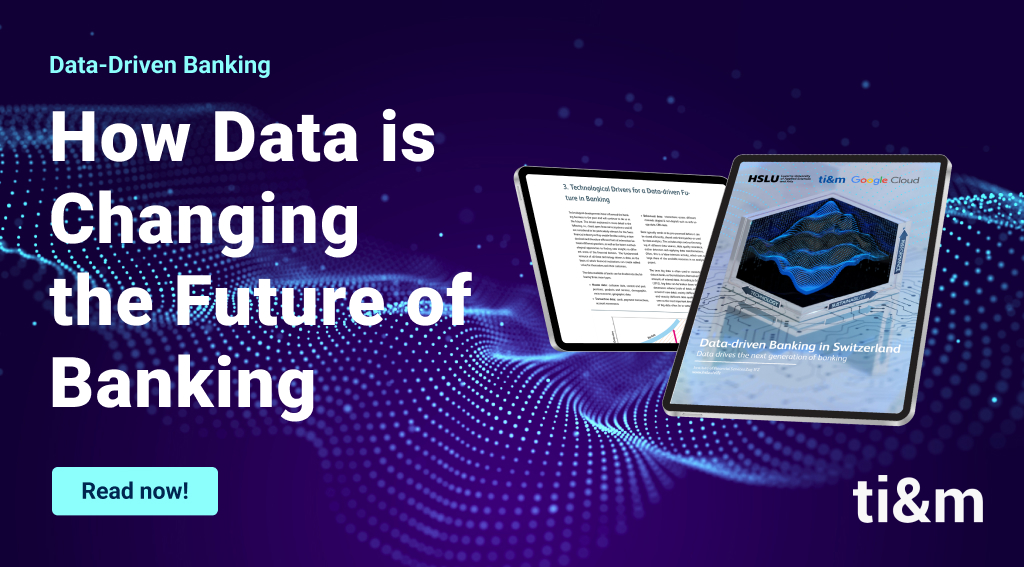Banks collect and hold huge quantities of usable data, and many are already successfully applying big data and AI across various business cases.
The potential to optimise data use through a data-driven banking strategy is enormous, especially for smaller banks. This is because even small projects can achieve clear added value with such a strategy.
This article, a collaboration between financial software provider ti&m and Google Cloud, appeared in the ti&m special on digital banking, exploring the use and potential of big data and AI in the banking sector.
The complete magazine offers further insights into various banking and technology trends.

Most banks have yet to really scratch the surface of data-driven banking. This is despite the fact that the potential of data analytics and AI in banking has been recognised and proven by industry experts, as shown by recent surveys on the subject.
However, for banks to remain successful in the future, they must continuously and dynamically adapt their business models to changing conditions.
The key drivers behind data-driven banking are technological and regulatory factors. Based on these factors, specific use cases for various levers for improving business performance (e.g., minimising costs, reducing risks, or increasing turnover) can be identified.
Technology drivers are pushing banks toward a data-driven future with AI

Technology is the key driver for data-driven banking. The drivers considered particularly relevant for the financial industry enable flexible scaling, standardised and hence efficient interaction between different providers, and the latest methodological approaches.
The fundamental resource behind all three technological drivers is data. This is the foundation on which financial institutions can create added value for both themselves and their customers.
The data available to banks can be divided into three main types: master data (including customer data and socioeconomic data), transaction data (e.g., payments, trades), and behavioral data (e.g., interactions across different channels).
The challenge often lies in setting up a suitable IT infrastructure and a data management system that collects and stores data from various (internal) sources. This calls for a sufficiently large amount of computing power.
The leap in technical possibilities brought about by AI research has produced a host of new innovations and business cases.
The main factors driving this process are innovations in the field of deep learning, a rapidly growing volume of available data, and access to relatively inexpensive computing power (e.g., via cloud computing).
Many banks are already using AI in one or more business cases, and a growing number of fintechs are also moving in this direction.
Great potential in many areas of banking

Source: Freepik
Applying data-driven banking can enhance banks’ performance through various levers.
Use cases such as automated customer onboarding or automated screening of potentially politically exposed persons can reduce costs for financial institutions.
Additionally, business risks in banking can be minimised through data-driven insights, for example, through more accurate default forecasts in the lending business.
Beyond improvements on the cost and risk side, data-driven banking can also benefit the revenue side.
Concrete applications like recommendation systems can help financial institutions increase their revenues through up- and cross-selling, higher conversion rates, and reduced customer churn.
Customers also directly benefit from improvements in personalisation and the customer experience, which in turn leads to higher customer satisfaction.
It’s all a matter of the right attitude
The technological and regulatory frameworks for a shift toward data-driven banking are already in place today. However, to successfully implement use cases, banks need to fundamentally change their mindset.
A compliance mentality often prevails, and this prevents or at least slows down innovation in many situations.
This mindset must be replaced with a technology- and data-friendly culture that enables companies to exploit the full potential of data-driven banking within the existing legal frameworks.
This article is based on the 28-page white paper “Data-driven Banking,” a collaborative work by Google Cloud, the Institute of Financial Services in Zug, Switzerland, and ti&m, offering an in-depth exploration of the topic.
About Author
More info about author
- SEO Powered Content & PR Distribution. Get Amplified Today.
- PlatoData.Network Vertical Generative Ai. Empower Yourself. Access Here.
- PlatoAiStream. Web3 Intelligence. Knowledge Amplified. Access Here.
- PlatoESG. Carbon, CleanTech, Energy, Environment, Solar, Waste Management. Access Here.
- PlatoHealth. Biotech and Clinical Trials Intelligence. Access Here.
- Source: https://fintechnews.sg/83769/bigdata/how-data-is-changing-the-future-of-banking/
- :has
- :is
- $UP
- 1
- 24
- 7
- a
- About
- access
- accurate
- Achieve
- across
- adapt
- added
- AI
- ai research
- All
- already
- also
- amount
- an
- analytics
- and
- appeared
- applications
- Applying
- approaches
- ARE
- areas
- article
- AS
- At
- author
- Automated
- available
- Banking
- banking sector
- Banks
- based
- BE
- because
- been
- begin
- behind
- benefit
- between
- Big
- Big Data
- both
- brought
- business
- business models
- by
- Calls
- CAN
- caps
- cases
- challenge
- change
- changing
- channels
- clear
- Cloud
- cloud computing
- collaboration
- collaborative
- collect
- Companies
- compliance
- computing
- computing power
- conditions
- considered
- content
- continuously
- Conversion
- Cost
- Costs
- create
- Culture
- customer
- customer data
- customer experience
- Customer satisfaction
- Customers
- data
- Data Analytics
- data management
- data-driven
- deep
- deep learning
- Default
- Despite
- different
- digital
- digital banking
- direction
- directly
- divided
- down
- driver
- drivers
- driving
- dynamically
- e
- efficient
- enable
- enables
- end
- enhance
- enormous
- especially
- Even
- example
- existing
- experience
- experts
- Exploit
- exploration
- Exploring
- exposed
- fact
- factors
- field
- financial
- Financial institutions
- financial services
- fintech
- fintechs
- flexible
- For
- forecasts
- form
- Foundation
- frameworks
- from
- full
- fundamental
- fundamentally
- further
- future
- Google Cloud
- Growing
- Have
- head
- help
- hence
- High
- higher
- hold
- host
- hottest
- How
- However
- HTTPS
- huge
- identified
- implement
- improvements
- improving
- in
- in-depth
- Including
- Increase
- increasing
- industry
- industry experts
- info
- Infrastructure
- Innovation
- innovations
- insights
- Institute
- institutions
- interaction
- interactions
- internal
- into
- IT
- jpg
- Key
- large
- latest
- Leads
- Leap
- learning
- least
- Legal
- lending
- lies
- like
- mailchimp
- Main
- management
- many
- master
- Matter
- max-width
- Mindset
- models
- Month
- more
- moving
- must
- Need
- New
- news
- number
- of
- offering
- Offers
- often
- on
- Onboarding
- once
- ONE
- optimise
- or
- Paper
- particularly
- payments
- performance
- persons
- Place
- plato
- Plato Data Intelligence
- PlatoData
- politically
- possibilities
- Posts
- potential
- potentially
- power
- prevents
- process
- Produced
- projects
- proven
- provider
- providers
- Pushing
- rapidly
- Rates
- really
- recent
- recognised
- Recommendation
- reduce
- Reduced
- reducing
- regulatory
- relatively
- relevant
- remain
- replaced
- research
- resource
- revenue
- revenues
- right
- Risk
- risks
- satisfaction
- scaling
- scratch
- screening
- sector
- Services
- setting
- shift
- shown
- side
- Singapore
- situations
- slows
- small
- smaller
- socioeconomic
- Software
- Sources
- special
- specific
- stores
- Strategy
- subject
- successful
- Successfully
- such
- suitable
- Surface
- switzerland
- system
- Systems
- Technical
- technological
- Technology
- that
- The
- The Future
- their
- themselves
- These
- they
- this
- three
- Through
- to
- today
- topic
- toward
- trades
- transaction
- Trends
- TURN
- turnover
- types
- usable
- use
- using
- value
- various
- via
- volume
- which
- with
- within
- Work
- yet
- Your
- zephyrnet
- Zug















